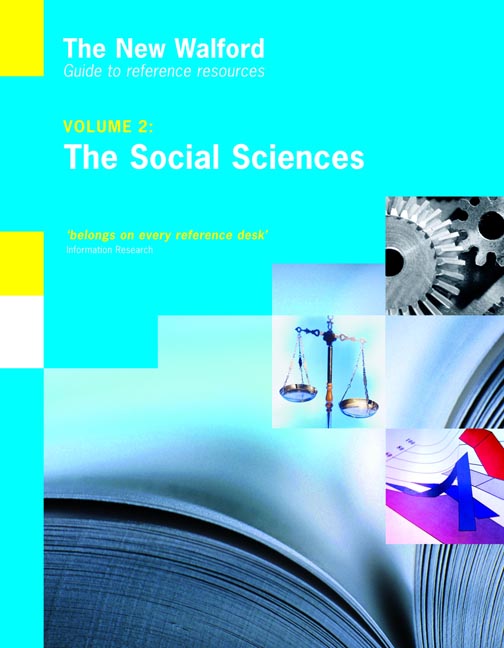Book contents
- Frontmatter
- Contents
- Preface
- Quick-start guide
- Editorial Board and Subject Specialists
- Introduction
- SOCIAL SCIENCES: GENERIC RESOURCES
- PSYCHOLOGY, SOCIOLOGY & SOCIAL WORK
- POLITICS, GOVERNMENT & LAW
- FINANCE, INDUSTRY & BUSINESS
- EDUCATION & SPORT
- MEDIA & INFORMATION
- TOOLS FOR INFORMATION PROFESSIONALS
- INDEXES
Quick-start guide
Published online by Cambridge University Press: 09 June 2018
- Frontmatter
- Contents
- Preface
- Quick-start guide
- Editorial Board and Subject Specialists
- Introduction
- SOCIAL SCIENCES: GENERIC RESOURCES
- PSYCHOLOGY, SOCIOLOGY & SOCIAL WORK
- POLITICS, GOVERNMENT & LAW
- FINANCE, INDUSTRY & BUSINESS
- EDUCATION & SPORT
- MEDIA & INFORMATION
- TOOLS FOR INFORMATION PROFESSIONALS
- INDEXES
Summary
How TNW is organized
Entries are hierarchically classified by subject area to four levels:
■ At the highest level are the Subject Parts, in the order Psychology, Sociology & Social Work; Politics, Law & Government; Finance, Industry & Business; Education & Sport; and Media & Information.
■ At the next level are the thirteen Subject Groupings, three each in Psychology, Sociology & Social Work, Politics, Law & Government and Finance, Industry & Business and two each in Education & Sport and Media & Information.
■ Each Grouping is then sub-divided into around one hundred Subject Fields.
■ In many of the Subject Groupings, where the subject demands more detailed categorization, subject fields have themselves been further subdivided in Subject Subfields.
■ There are also two generic collections of entries: one at the start, describing resources covering the whole of Social Sciences (and, in some cases, all disciplines); and one at the other end, highlighting tools that are especially valuable for information professionals.
Within this structure, descriptions of resources are allocated to one of the subject areas and then placed within one of thirteen Resource Categories:
[1] INTRODUCTIONS TO THE SUBJECT
[2] DICTIONARIES, THESAURI, CLASSIFICATIONS
[3] LAWS, STANDARDS, CODES
[4] OFFICIAL & QUASI-OFFICIAL BODIES
[5] RESEARCH CENTRES & INSTITUTES
[6] ASSOCIATIONS & SOCIETIES
[7] LIBRARIES, ARCHIVES & MUSEUMS
[8] PORTAL & TASK ENVIRONMENTS
[9] DISCOVERING PRINT & ELECTRONIC RESOURCES
[10] DIGITAL DATA, IMAGE & TEXT COLLECTIONS
[11] DIRECTORIES & ENCYCLOPEDIAS
[12] HANDBOOKS & MANUALS
[13] KEEPING UP TO DATE
For around a quarter of the resources, we have appended descriptions of associated or related resources (for example, additional items from the same producer or alternative views of the subject).
We do not duplicate or cross-reference entries within the set of resource categories for a specific subject area: if a resource description could equally well be placed within two (or more) categories, it will usually appear in the category earliest in the sequence. However, we do frequently cross-reference (but not duplicate) resource descriptions between different subject areas. In a few special instances, mainly in the section on Law, the same resource has been given an entry in several subject subfields, where a part of that resource is in itself an important authority in the narrow focus of the subfield; for similar reasons the key resource Intute has its own entry in several of TNW's subject sections.
- Type
- Chapter
- Information
- The New Walford Guide to Reference ResourcesSocial Sciences, pp. viii - ixPublisher: FacetPrint publication year: 2007

